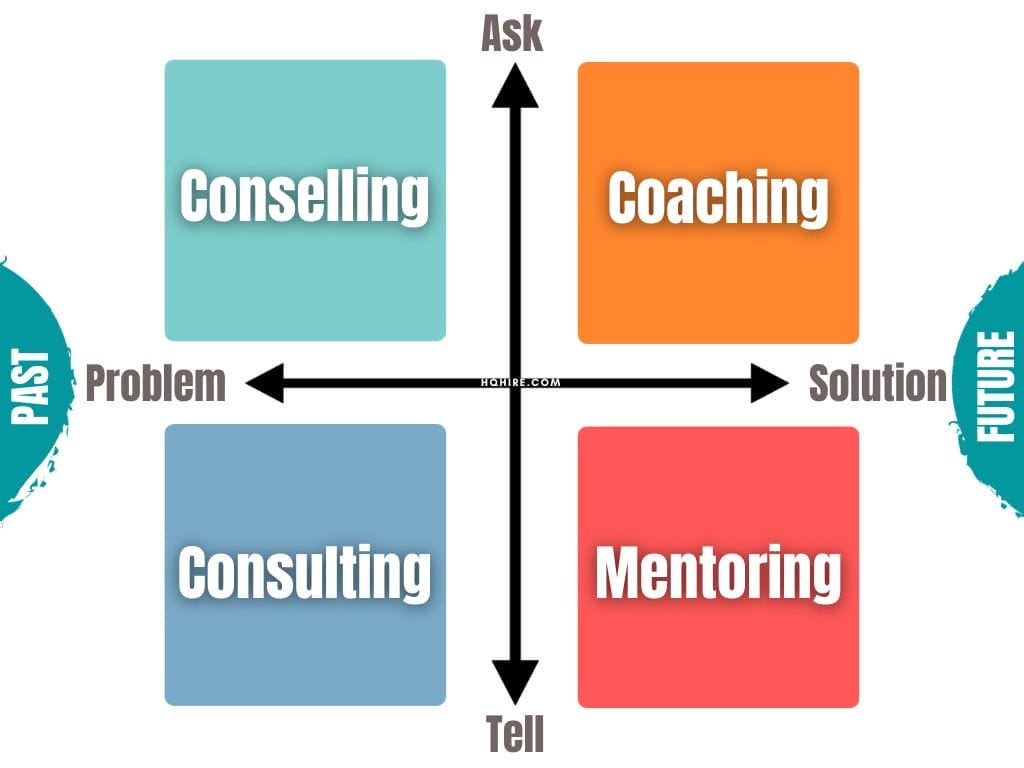Every type of leadership style is different in some way or other. Some leaders are more open and others are less so, each has their own personality traits which will affect how they lead.
There are a specific leadership style focuses on offering constructive feedback that helps in professional development, a one-on-one coaching approach to leadership. These leaders are called “coach-leaders”.
Coaching leaders don’t just tell people what to do; instead, they encourage them by showing them examples of good practice. This type of leader can be found everywhere from sports teams to business organizations.

What is Coaching Leadership Style
Coaching leadership is the act of providing guidance to employees and team member in order to improve their performance in the workplace.
Leaders who adopt the coaching leadership style engage with their mentees and provide guidance and encouragement that will lead to growth and development of the individual and team.
Coaching leaders help others develop skills that enable them to perform better at work. The goal of this approach is not only to increase productivity but also to foster an environment where everyone feels valued and respected.
People who are led by a coaching leader will grow into better versions of themselves. They become more confident, self-assured, and productive.
Coaching Style of Leadership Characteristics
Coaching leaders are leaders who foster creativity and strategic thinking in their people. More importantly, they act as coaches to help employees act on their ideas. They are firm but flexible, with the best interest of the team in mind.
Coaching leaders have the following characteristics.
- Knowledgable. Coaching leaders are knowledgeable, skilled professionals who have the capability to nurture those around them in order for them to succeed.
- High Emotional Intelligence (EQ). Coaching leaders have high EQ which allows them to be genuine, compassionate, and empathise with others as they guide them through the challenges they face.
- Open-minded. Coaching leaders have a good knowledge of what needs to be done to achieve success, but they are also open to ideas to help foster creativity and strategic thinking in their people.
Advantages And Disadvantages of Using the Coaching Leadership Style
Effective coaching helps to nurture a growth mindset, helps in personal development and employee development in the workplace. However, like all types of leadership approach, coaching leaders need a certain level of coaching skills to make it work.
Let’s take a look at some of the strengths and weaknesses of coaching leadership style.
Advantages of Coaching Leadership
There are many advantages for leaders to use coaching leadership. Many of these advantages can have both short-term which provide immediate results and long-term benefits that prepare the people for future challenges and reaching long-term goals.
1. Help People to Grow
Leaders who adopt coaching leadership transform the employees’ lives by helping them grow personally and professionally. They provide guidance on how to improve performance and develop skills that will enable individuals to reach their full potential.
This is because these leaders understand that growth comes from within an individual rather than external factors such as education or training.
Coaching leaders help individuals develop skills that are needed by organizations including communication, negotiation, conflict resolution, problem-solving, decision making, and leadership.
They also provide feedback so that people can learn how to improve performance.
This is done through coaching conversations where the leader asks questions such as: “What are your thoughts?”
2. Positive Engagement
Coaching leaders help to build positive engagement with the organization’s culture by encouraging employees to be open about what matters most to them in order to achieve success.
Coaching leaders encourage their people to grow within the organization, this helps people feel more connected to others at work and increases job satisfaction.
Discuss personal goals, career aspirations, strengths and weaknesses, values, and beliefs.
3. Shared Responsibility
Coaching leaders encourage others to take responsibility for themselves and their own development. As a result, they become more self-reliant and less reliant upon other people.
The leader help individuals develop skills that will enable them to succeed on their own without relying on external support from managers or colleagues.
Individuals will become more effective in dealing with difficult situations when working alone.
Coaching leaders nurture workers to become capable to perform work independently.
Disadvantages of Coaching Leadership
Coaching leadership is about listening to the demands of employees and then providing guidance to help them grow. While this is a great way for bosses and managers to support their team, there are times when they cannot give advice on topics that are sensitive which makes coaching leadership a challenge.
1. Hard to Manage
Coaching leadership can be hard to adopt as it involved the management of all the different personalities on your team. It requires you to have an open mind in order to understand what each person needs from you.
This also means that if one employee does not like being coached by another manager or boss, it will make things more complicated than necessary.
A clear understanding of each person’s strengths and weaknesses is required to create a productive environment.
2. High Interpersonal Skills Required
Coaching leadership requires the leader to have high level of communication skills and interpersonal skills. Effective interpersonal skills are important to help find a balance between honesty and kindness in order for people not to feel attacked by their leader.
It can be difficult to know when someone has been hurt by your coaching style, but this should never stop you from trying to improve yourself as a leader.
As a coaching leader, you need to learn how to listen carefully without interrupting others while at the same time giving them enough space to express themselves freely.
This is an art that takes practice, patience, and humility.
The best coaching leaders will always try to understand what makes each person unique so they can better serve them.
3. High Commitment of Time and Energy
Coaching leadership requires the leader to have the high commitment of his time and energy to help people grow in their careers. The coach must be willing to invest himself into helping someone else succeed. The more invested he becomes in developing others, the greater impact the leader will make on their lives.
It also means having empathy towards those who are struggling or not succeeding as well as understanding where they come from.
The leader needs to put aside their own agenda for the sake of another’s success. In order to do this, he has to develop a thick skin because it means being vulnerable to other people.
Coaching Leadership vs Servant Leadership
While both coaching leadership and servant leadership’s goal is to help employees achieve their full potential in order to increase the productivity of the organization.
Coaching leadership and servant leadership have a few striking differences. Coaching leadership centers around improving performance through assessment, feedback, and goal-setting. Servant leadership is the act of selflessly serving others to help them achieve their goals.
Servant leaders always looking for how they can help those around them and put their needs aside to focus on the betterment of others.
Coaching Leaders focus on helping individuals understand and pursue their passions and core values so that they can grow and maximize their potential.
When is Coaching Leadership Management Style Effective?
Coaching leadership is effective in many situations, coaching is practically a leadership practice itself.
- Effective when the leader wants to provide feedback, set goals, and help employees grow.
- Effective when the organization needs to generate a different perspective and get support when needed.
- Effective when the leader wants to nurture workers who are seeking career growth and personnel development.
- Effective when the leader needs to help build trust with their people.
Leadership is practically a practice of coaching itself. It relies on someone else to provide feedback that can lead to change in a person’s professional, personal, or social life.
Real-Life Examples of Coaching Leaders
Best coaching leaders are those who provide support and encouragement to their employees. Know how to make tough decisions, and care about the well-being of the people they’re leading.
Here are a few famous coaching leaders throughout our history.
Famous Coaching Leaders in Politics:
- Winston Churchill
- Abraham Lincoln
- Martin Luther King Jr.
Did you know that these leaders were also coaches? They coached their countries through some of the most difficult periods in world history. What’s more, they did it with innate leadership qualities like empathy, grit, and humility.
“A genuine leader is not a searcher for consensus but a molder of consensus.”
Martin Luther King, Jr.
Famous Coaching Leaders in Business:
- Richard Branson
- Oprah Winfrey
- Colonel Sanders
- Charles Schwab
- Dale Carnegie
Coaching leaders are the individuals who provide guidance and support to help you accomplish your goals. They are both mentors and coaches.
“Do not be embarrassed by your failures, learn from them and start again.”
Richard Branson
Join over 11,000+ achievers who are committed to achieving their career goals!






